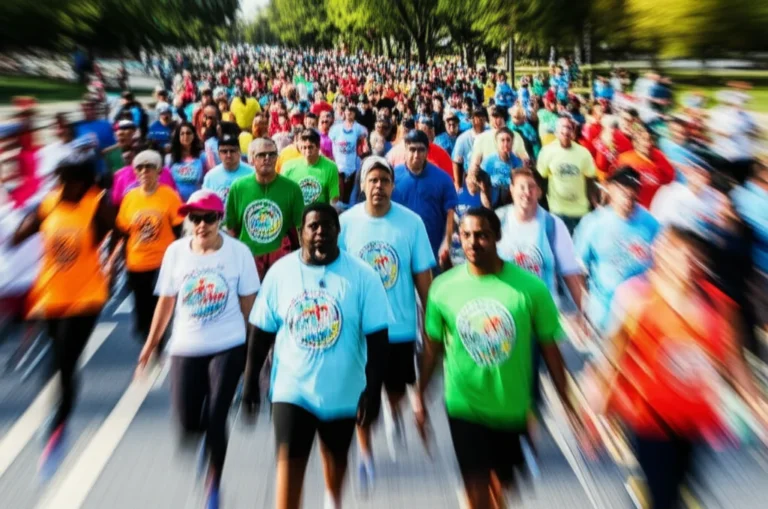Support our educational content for free when you purchase through links on our site. Learn more
How Many Miles Is a Walkathon? 6 Distances You Should Know (2025) 🚶♂️
Ever wondered exactly how many miles a walkathon covers? You’re not alone! Whether you’re signing up for your first charity walk or just curious about what to expect, the answer isn’t as straightforward as you might think. From quick 1K fun walks to ultra-endurance marathons, walkathons come in all shapes and sizes — and each mile tells a story. Stick around as we unravel the mystery behind walkathon distances, share insider tips from our Walkathon Virtual™ trainers, and help you find the perfect stride for your next event.
Here’s a teaser: Did you know some walkathons can span over 50 miles? But don’t worry — most fall between 1 and 10 miles, making them accessible for nearly everyone. Ready to discover which walkathon distance fits you best? Let’s dive in!
Key Takeaways
- Walkathon distances vary widely, typically ranging from 1 mile to ultra-marathon lengths beyond 26.2 miles.
- The most popular distances are 5K (3.1 miles) and 10K (6.2 miles), balancing challenge and accessibility.
- Factors like event purpose, terrain, and participant fitness influence the chosen distance.
- Proper training, hydration, and pacing are essential to enjoy your walkathon experience.
- Virtual walkathons offer flexibility to walk your own route and distance anytime, anywhere.
- Check out top walking shoes like Brooks Addiction Walker and New Balance 928v3 to stay comfortable and supported.
👉 Shop walking shoes and gear:
- Brooks Addiction Walker: Amazon | Brooks Official Website
- New Balance 928v3: Amazon | New Balance Official Website
Ready to step up? Your perfect walkathon distance awaits!
Table of Contents
- ⚡️ Quick Tips and Facts
- 🤔 The Great Walkathon Mystery: Unraveling the Miles and Their Meaning
- 📏 So, How Many Miles Is a Walkathon, Really? The Short Answer & The Long Answer to Walkathon Distances
- 🚶♀️ The Spectrum of Strides: Common Walkathon Distances Explained
- ❓ Why the Variation? Factors Influencing Walkathon Length and Your Experience
- 👟 Lacing Up for Success: Preparing for Your Walkathon Journey with Training Tips
- 💖 Beyond the Finish Line: The True Impact of Walkathons on Community and Cause
- 🎯 Finding Your Perfect Pace: Choosing the Right Walkathon Event for Your Goals
- 🚀 Walkathon Virtual™: Your Partner in Pavement Pounding (and Beyond!)
- 📜 Legends of the Long Walk: Famous Walkathons and Their Enduring Legacies
- 🤝 Walkathon Etiquette: Pacing, Hydration, and Good Vibes on the Course
- 🧘♀️ Post-Walkathon Recovery: Recharging Your Batteries and Celebrating Your Achievement
- ✅ Conclusion: Every Mile Matters, No Matter the Distance!
- 🔗 Recommended Links: Your Next Steps on the Walkathon Path
- ❓ FAQ: Your Walkathon Questions Answered
- 📚 Reference Links: The Sources Behind Our Strides
⚡️ Quick Tips and Facts
Welcome to the ultimate guide on how many miles is a walkathon? Whether you’re a seasoned walker or a curious newbie, we at Walkathon Virtual™ have your back (and your feet!). Before we lace up, here are some quick nuggets to get you started:
- Walkathons vary widely in distance — from less than a mile to ultra-marathon lengths.
- The most common distances are 5K (3.1 miles) and 10K (6.2 miles), but many events customize lengths based on cause and audience.
- Walkathons are often designed to be inclusive, so you’ll find shorter fun walks alongside more challenging routes.
- The average walkathon distance tends to hover around 3 to 6 miles.
- Virtual walkathons let you pick your own route and distance — perfect for all fitness levels.
- Hydration and pacing are key — don’t sprint unless you want to regret it later! 🚰
- Walkathons are more about community and fundraising than speed or distance.
For a deep dive into walkathon distances, check out our related article on Walkathon Distance Demystified: 7 Key Distances to Know (2025) 🚶♂️♂️.
🤔 The Great Walkathon Mystery: Unraveling the Miles and Their Meaning
Ever wondered why walkathons don’t have a fixed mileage? It’s like asking, “How long is a piece of string?” The answer depends on the event’s goals, location, and participants.
Walkathons started as community fundraisers, often organized by schools, charities, or health organizations. The distance was chosen to be accessible, encouraging participation from all ages and fitness levels. Over time, the distances evolved, sometimes reflecting popular race lengths like 5K or 10K, or tailored to specific challenges.
Our team at Walkathon Virtual™ has seen walkathons ranging from a casual 1-mile stroll to grueling 50-mile ultra-walks! The key takeaway? There’s no one-size-fits-all distance — it’s about the journey and the cause.
📏 So, How Many Miles Is a Walkathon, Really? The Short Answer & The Long Answer to Walkathon Distances
Short answer: Most walkathons fall between 1 mile and 10 miles.
Long answer: It depends on the event’s purpose, terrain, and participant demographics. Some walkathons are designed as family-friendly fun walks (think 1-2 miles), while others challenge endurance athletes with marathon or ultra distances.
Here’s a quick comparison table from our experience:
| Walkathon Type | Typical Distance Range | Who It’s For | Example Event |
|---|---|---|---|
| Fun Walk | 1 – 2 miles | Families, beginners, casual walkers | Local school fundraisers |
| Standard Walkathon | 3 – 6 miles | Most participants | American Cancer Society Walk |
| Challenge Walk | 10+ miles | Experienced walkers, fitness buffs | Charity marathons, ultra-walks |
🚶♀️ The Spectrum of Strides: Common Walkathon Distances Explained
Let’s break down the most popular walkathon distances, so you know what to expect and how to prepare.
1. The Speedy Sprint: 1K (0.62 Miles) 🏃♀️
- Who’s it for? Young kids, beginners, or those wanting a quick, social stroll.
- Why it works: It’s short enough to be fun, inclusive, and manageable for all fitness levels.
- Our tip: Perfect for families or virtual walkathons where participants can choose their own pace.
2. The Popular Pace: 5K (3.1 Miles) 🚶♂️
- Who’s it for? Most walkathon participants — casual walkers to fitness enthusiasts.
- Why it works: It’s a classic distance that’s challenging but achievable.
- Pro tip: Training for a 5K walkathon can boost cardiovascular health and endurance. Check out our Distance Walking Techniques for expert advice.
3. The Double-Digit Dash: 10K (6.2 Miles) 💨
- Who’s it for? Intermediate walkers looking for a solid challenge.
- Why it works: It pushes your stamina while still being accessible.
- Trainer insight: Incorporate interval walking and hill training to prepare.
4. The Half-Marathon Heroics: 13.1 Miles 🏅
- Who’s it for? Seasoned walkers and those seeking a serious fitness goal.
- Why it works: It’s a major accomplishment with huge health benefits.
- Our advice: Build up mileage gradually and focus on nutrition and hydration strategies.
5. The Full Marathon Feat: 26.2 Miles 🏆
- Who’s it for? Ultra-fit walkers and charity warriors.
- Why it works: It’s a test of endurance, mental grit, and commitment.
- Pro tip: Cross-train and consult professionals to avoid injury.
6. The Ultra-Endurance Epic: Beyond the Marathon! 🌟
- Who’s it for? Ultra-athletes and dedicated fundraisers.
- Why it works: It’s a monumental challenge that raises awareness and funds.
- Fun fact: Some walkathons span 50+ miles, sometimes over multiple days!
❓ Why the Variation? Factors Influencing Walkathon Length and Your Experience
Several factors shape walkathon distances:
- Cause and Fundraising Goals: Longer distances can attract more sponsorships.
- Target Audience: Family-friendly events keep distances short; fitness-focused ones push longer.
- Location and Terrain: Urban parks vs. rugged trails affect feasible distances.
- Event Format: Virtual walkathons allow participants to choose their own mileage.
- Weather and Season: Hot climates often favor shorter routes.
Our trainers emphasize that choosing the right distance for you is key to enjoying the event and staying injury-free.
👟 Lacing Up for Success: Preparing for Your Walkathon Journey with Training Tips
Ready to crush your walkathon? Here’s how to prep like a pro:
- Start Early: Build endurance gradually, increasing distance by 10% per week.
- Mix It Up: Combine steady-state walks with interval training.
- Gear Up: Invest in quality walking shoes like the Brooks Addiction Walker or New Balance 928v3 for support.
- Hydrate: Practice drinking water during your training walks.
- Fuel Smart: Eat balanced meals with carbs and protein.
- Listen to Your Body: Rest if you feel pain or excessive fatigue.
Our health pros recommend tracking progress with apps like MapMyWalk or Strava to stay motivated.
👉 CHECK PRICE on:
- Brooks Addiction Walker: Amazon | Brooks Official Website
- New Balance 928v3: Amazon | New Balance Official Website
💖 Beyond the Finish Line: The True Impact of Walkathons on Community and Cause
Walkathons are more than miles—they’re about making a difference. Whether raising funds for cancer research, supporting local schools, or promoting health awareness, every step counts.
Our team has witnessed firsthand how walkathons:
- Build community spirit and camaraderie.
- Inspire healthy lifestyle changes.
- Generate vital funds for charities.
- Raise awareness on important issues.
One of our trainers shares: “I once walked a 10K for a local children’s hospital. The energy and shared purpose made every mile feel lighter.”
🎯 Finding Your Perfect Pace: Choosing the Right Walkathon Event for Your Goals
Not all walkathons are created equal. Here’s how to pick yours:
- Assess Your Fitness Level: Beginners might start with 1-3 miles; seasoned walkers can aim for 10+.
- Consider the Cause: Pick a cause close to your heart for extra motivation.
- Check the Terrain: Flat urban routes vs. hilly trails require different preparation.
- Virtual vs. In-Person: Virtual walkathons offer flexibility; in-person events offer community buzz.
- Event Size: Large events can be thrilling but crowded; smaller ones are intimate and relaxed.
Explore our Global Walkathon Events for inspiration!
🚀 Walkathon Virtual™: Your Partner in Pavement Pounding (and Beyond!)
At Walkathon Virtual™, we specialize in connecting walkers worldwide through virtual events that let you choose your distance, pace, and route. Here’s why we’re your go-to:
- Flexibility: Walk anytime, anywhere.
- Community: Join thousands of walkers supporting causes globally.
- Tracking: Use our app to log miles, share stories, and celebrate milestones.
- Fundraising Tools: Easy-to-use platforms to maximize donations.
- Expert Guidance: Training plans, nutrition tips, and motivation from certified trainers.
Join us and turn your steps into impact! Check out our Fundraising Ideas and Event Promotion resources to boost your event success.
📜 Legends of the Long Walk: Famous Walkathons and Their Enduring Legacies
Walkathons have a rich history with some legendary events:
- Jerry Lewis MDA Labor Day Telethon Walkathon: A famous fundraising walk that spanned multiple miles to support muscular dystrophy research.
- Susan G. Komen Race for the Cure: Often 5K, this walkathon has raised millions for breast cancer awareness.
- The AIDS Walk: Held in cities worldwide, distances vary but the impact is massive.
- The March of Dimes Walk: Focuses on premature birth prevention with walks typically around 3-5 miles.
These events show how walkathons can unite communities and change lives, one step at a time.
🤝 Walkathon Etiquette: Pacing, Hydration, and Good Vibes on the Course
Walking a walkathon isn’t just about putting one foot in front of the other. It’s a social event with its own unwritten rules:
- Pace Yourself: Start slow and find a rhythm that feels sustainable.
- Stay Hydrated: Use water stations generously.
- Be Courteous: Pass on the left, say “on your left” when overtaking.
- Keep It Positive: Cheer fellow walkers and volunteers.
- Dress Appropriately: Weather-appropriate clothing and comfortable shoes are a must.
Our trainers say, “A smile and a friendly nod go a long way in making the walk enjoyable for everyone.”
🧘♀️ Post-Walkathon Recovery: Recharging Your Batteries and Celebrating Your Achievement
You crossed the finish line — now what? Recovery is crucial to avoid soreness and injury:
- Cool Down: Walk slowly for 5-10 minutes post-event.
- Stretch: Focus on calves, hamstrings, and hips.
- Hydrate and Refuel: Drink water and eat a balanced snack with protein and carbs.
- Rest: Give your body time to recover, especially after longer distances.
- Celebrate: Share your achievement with friends, family, or your Walkathon Virtual™ community.
Our pro tip: Keep a recovery journal to track how your body feels and improve for next time!
✅ Conclusion: Every Mile Matters, No Matter the Distance!
So, how many miles is a walkathon? The honest answer is: it depends — and that’s the beauty of it! From quick 1K strolls to ultra-endurance challenges, walkathons are designed to be inclusive, impactful, and fun. Whether you’re walking for a cause, your health, or just to enjoy the outdoors, every step counts.
At Walkathon Virtual™, we’ve seen firsthand how walkathons transform communities and lives, regardless of the distance. Remember, it’s not about racing the clock or covering the most miles; it’s about joining together, making a difference, and celebrating every stride.
If you’re gearing up for your first walkathon or your fiftieth, choose a distance that fits your goals and fitness level, prepare smartly, and soak in the experience. Your journey is uniquely yours — and we’re here to support every step of the way!
🔗 Recommended Links: Your Next Steps on the Walkathon Path
Ready to gear up or learn more? Here are some top picks and resources to keep you moving:
-
Brooks Addiction Walker Shoes:
Amazon | Brooks Official Website -
New Balance 928v3 Shoes:
Amazon | New Balance Official Website -
MapMyWalk App:
Official Website -
Strava App:
Official Website -
Books to Inspire Your Walkathon Journey:
Explore our Fundraising Ideas and Health Benefits of Walkathons for more inspiration!
❓ FAQ: Your Walkathon Questions Answered
What is the average distance of a charity walkathon?
Most charity walkathons average between 3 to 6 miles (5K to 10K). This range balances accessibility for a wide audience with a meaningful physical challenge that encourages fundraising and awareness. Shorter distances (1-2 miles) are common for family-friendly events, while longer distances cater to fitness enthusiasts.
How long does it take to complete a walkathon?
Completion time depends on distance and walking pace. For example:
- A 5K (3.1 miles) typically takes 45 minutes to 1 hour at a moderate pace.
- A 10K (6.2 miles) may take 1.5 to 2 hours.
- Longer distances like half-marathons or marathons can take several hours or more.
Remember, walkathons are not races — pacing yourself and enjoying the experience is key.
What are the different types of walkathons and their distances?
Walkathons vary widely:
- Fun Walks: 1-2 miles, casual and family-friendly.
- Standard Walkathons: 3-6 miles, popular for charity events.
- Challenge Walks: 10+ miles, for experienced walkers.
- Virtual Walkathons: Flexible distances, walk anytime anywhere.
- Ultra Walkathons: 26+ miles, endurance events.
Each type serves different goals, from socializing and fundraising to fitness challenges.
Can I participate in a virtual walkathon from anywhere in the world?
✅ Absolutely! Virtual walkathons are designed for global participation. You choose your own route, distance, and time frame, making it perfect for busy schedules or remote locations. Just register online, track your miles with apps like MapMyWalk or Strava, and share your progress with the community.
How should I train for a walkathon if I’m a beginner?
Start slow and build endurance gradually. Aim to walk at least 3 times a week, increasing your distance by no more than 10% weekly. Incorporate rest days and cross-training like swimming or cycling to avoid injury. Invest in good walking shoes and practice hydration and nutrition strategies.
What are the health benefits of participating in walkathons?
Walking regularly improves cardiovascular health, boosts mood, aids weight management, and strengthens muscles and bones. Walkathons add social motivation and a sense of purpose, enhancing mental well-being and community connection.
📚 Reference Links: The Sources Behind Our Strides
- American Heart Association: Benefits of Walking
- Mayo Clinic: Walking: Trim your waistline, improve your health
- Brooks Running Official Site: Brooks Addiction Walker
- New Balance Official Site: New Balance 928v3
- MapMyWalk: Official Website
- Strava: Official Website
- Facebook Group Post on Jerry Lewis Walkathon: Who remembers how long the Jerry Lewis walkathon was? How …
We hope this guide has answered your burning questions and inspired you to step out and join the walkathon movement. Remember, every mile you walk supports a cause and moves you closer to a healthier, happier you! 🚶♀️🚶♂️💪





